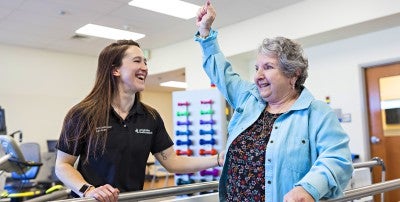
One night in February 2017, Pen Argyl, Pa., couple Rose and Wayne Brotzman went to bed like any other evening in their half-century-plus marriage. Then everything changed.
“I heard her get up in the middle of the night,” Wayne says, “then when she was coming back to bed, I noticed that only one arm and one leg were working. The rest was being dragged behind. I knew at that point something was wrong because she’d had two minor strokes before.”
Rose was taken to Lehigh Valley Hospital (LVH)–Muhlenberg, one of three accredited Primary Stroke Centers throughout Lehigh Valley Health Network, where a scan confirmed a brain bleed on the right side. “I can remember our daughter-in-law saying, ‘This isn’t good,’” Wayne says. She was right. Because Rose needed critical care, she was transferred by ambulance to LVH–Cedar Crest and admitted to the neuroscience intensive care unit (NSICU), where her long road to recovery began.
Countering left-side neglect
Rose’s stroke caused “left-side neglect,” says neurologist Adam Edwards, MD, with LVPG Neurology. “It’s as if the left side of her body was not her own, and the left side of her world didn’t exist.”
“You would sit her up in bed, and she would tip over like a bowling pin,” Wayne says.
Left-side neglect was one of many components to Rose’s inpatient rehabilitation, which started almost immediately after her stroke. “It is very important, as soon as patients are medically stable, to get them into rehabilitation,” explains physical therapist Trisha Collins, who worked with Rose at the Inpatient Rehabilitation Center at LVH–Cedar Crest. “The earlier you get moving, the more brain recovery you can get,” says Collins. Staying immobile too long also can lead to muscle and bone loss, and puts you at risk for blood clots.
During rehabilitation, physical therapy, occupational therapy and speech therapy all work together. “The general goal of inpatient rehabilitation is to maximize your independence and functional recovery,” Collins says.
Speaking and swallowing again
Speech therapy isn’t limited to helping someone learn to speak after a stroke. A speech language pathologist (SLP) like Doris Golebiewski, with Inpatient Rehabilitation Center–Cedar Crest, helps people learn to swallow again.
“Due to weakness on one side of her body, chewing food was difficult for Rose,” says Golebiewski. “Fortunately, through consistent and intense interventions, including oral strengthening and stimulation exercises, Rose improved her swallowing function and was enjoying a regular diet when she was discharged home.”
Rehab sweet rehab
Once home, Rose’s recovery continued. Occupational therapist Victoria Weber, Lehigh Valley Health Network Outpatient Rehabilitation, began working with her at the Health Center at Palmer Township, primarily addressing left-side neglect.
“Her husband has been great about sitting on her left side so she has to turn to see him,” Weber says. And cups and plates that used to frequently fly off the dinner table at home (due to Rose’s limited awareness of what her left arm or hand might be doing), fly a lot less often.
Occupational therapy also improves tasks of everyday living – like getting dressed, taking showers and putting on deodorant independently. The last skill was a recent victory, Rose says. “Everything has not been hard – but frustrating – because I was always very independent,” she says. “I did everything myself, for myself, by myself, and all of a sudden I couldn’t. I couldn’t even wash myself.”
Sparkling motivation: An emerald anniversary
Wayne has helped to make adjustments at home so that Rose’s recovery includes little victories. For example, he installed a sliding tub seat so he can get Rose settled in for a shower, and he can leave so she can wash independently.
“The biggest thing was having to care for her completely,” he says, “and then knowing when not to care for her completely.”
While Rose continues to heal, the couple has a big goal in mind for 2018 – dancing together on their 55th wedding anniversary, their emerald anniversary. It’s a day they will celebrate their long marriage as well as the rare love that supports each other through sickness – and rehab – and health.
